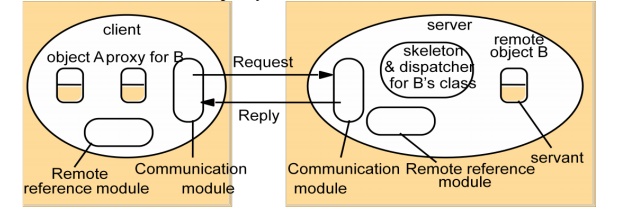Chapter: Distributed Systems : Communication in Distributed System
Remote method invocation(RMI)
Remote method invocation(RMI)
Design Issues for RMI
·
Two design issues that arise in extension of local
method invocation for RMI
o
The choice of invocation semantics
·
Although local invocations are executed exactly
once, this cannot always be the case for RMI due to transmission error
o
Either request or reply message may be lost
o
Either server or client may be crashed
o
The level of transparency
·
Make remote invocation as much like local invocation
as possible
RMI Design Issues: Invocation Semantics
·
Error handling for delivery guarantees
o
Retry request message: whether to retransmit the
request message until either a reply is received or the server is assumed to
have failed
o
Duplicate filtering: when retransmissions are used,
whether to filter out duplicate requests at the server
o
Retransmission of results: whether to keep a
history of result messages to enable lost results to be retransmitted without
re-executing the operations
·
Choices of invocation semantics
o
Maybe: the method executed once or not at all (no
retry nor retransmit)
o
At-least-once: the method executed at least once
o
At-most-once: the method executed exactly once
Invocation semantics: choices of interest

RMI Design Issues: Transparency
·
Transparent remote invocation: like a local call
o
marshalling/unmarshalling
o
locating remote objects
o
accessing/syntax
·
Differences between local and remote invocations
o
latency: a remote invocation is usually several order
of magnitude greater than that of a local one
o
availability: remote invocation is more likely to
fail
o
errors/exceptions: failure of the network? server?
hard to tell
·
syntax might need to be different to handle
different local vs remote errors/exceptions (e.g. Argus)
o
consistency on the remote machine:
·
Argus: incomplete transactions, abort, restore
states [as if the call was never made]
Implementation of RMI
·
•Communication module
o
Two cooperating communication modules carry out the
request-reply protocols: message type, request ID, remote object reference
·
Transmit request and reply messages between client
and server
·
Implement specific invocation semantics
o
The communication module in the server
·
selects the dispatcher for the class of the object
to be invoked,
·
passes on local reference from remote reference
module,
·
returns request
The role of proxy and skeleton in remote method
invocation

Remote reference module
o
Responsible for translating between local and
remote object references and for creating remote object references
o
remote object table: records the correspondence
between local and remote object references
–
remote objects held by the process (B on server)
–
local proxy (B on client)
o
When a remote object is to be passed for the first
time, the module is asked to create a remote object reference, which it adds to
its table
Servant
– An
instance of a class which provides the body of a remote object
– handles
the remote requests
•RMI software
– Proxy:
behaves like a local object, but represents the remote object
– Dispatcher:
look at the methodID and call the corresponding method in the skeleton
– Skeleton:
implements the method
Generated
automatically by an interface compiler
Implementation Alternatives of RMI
Dynamic invocation
Proxies
are static—interface complied into client code
Dynamic—interface
available during run time
Generic invocation; more info in ―Interface
Repository‖ (COBRA)
Dynamic loading of classes (Java RMI)
•Binder
A
separate service to locate service/object by name through table mapping for
names and remote object references
Activation of remote objects
o
Motivation: many server objects not necessarily in
use all of the time
§ Servers
can be started whenever they are needed by clients, similar to inetd
o
Object status: active or passive
§ active:
available for invocation in a running process
§ passive:
not running, state is stored and methods are pending
o
Activation of objects:
§
creating an active object from the corresponding
passive object by creating a new instance of its class
§ initializing
its instance variables from the stored state
o
Responsibilities of activator
§ Register
passive objects that are available for activation
§ Start
named server processes and activate remote objects in them
§
Keep track of the locations of the servers for
remote objects that it has already activated
Persistent object stores
o
An object that is guaranteed to live between
activations of processes is called a
o
persistent object
o
Persistent object store: managing the persistent
objects
o
stored in marshaled from on disk for retrieval
o
saved those that were modified
o
Deciding whether an object is persistent or not:
o
persistent root: any descendent objects are
persistent (persistent Java, PerDiS)
o
some classes are declared persistent (Arjuna
system)
o
Object location
o
specifying a location: ip address, port #, ...
o
location service for migratable objects
o
Map remote object references to their probable
current locations
§ Cache/broadcast
scheme (similar to ARP)
o
Cache locations
o
If not in cache, broadcast to find it
o
Improvement: forwarding (similar to mobile IP)
Distributed Garbage Collection
– Aim:
ensure that an object
o
continues to exist if a local or remote reference
to it is still held anywhere
o
be collected as soon as no object any longer holds
a reference to it
– General
approach: reference count
– Java's
approach
o
the server of an object (B) keeps track of proxies
o
when a proxy is created for a remote object
– addRef(B)
tells the server to add an entry
o
when the local host's garbage collector removes the
proxy
– removeRef(B)
tells the server to remove the entry
o
when no entries for object B, the object on server
is deallocated
Related Topics